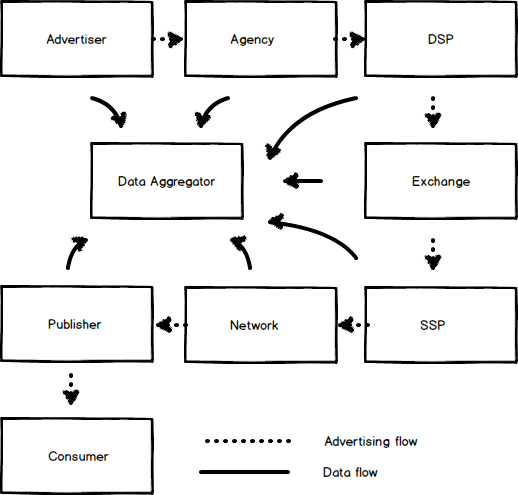Here at east vision systems almost all projects built for the advertising industry involve some Big Data technologies. From metrics analytics to fraud detection, predictive analytics and targeting, the solutions for these challenges are largely based on large amounts of collected data. In this day and age data is the bread and butter of the advertising industry.
Today’s technology landscape is very complex. While growing volume of data challenges marketers to simply keep up, new tools and technologies are changing the face of the industry. While most of them are SaaS based, one thing remains clear when it comes to ad tech. No single “one-size-fits-all” solution can address every marketer’s need.
In this blog post we will explore how big data impacts ad media buying and how these technologies improve overall campaign performances.
Data Management Platforms (DMPs)
The data management platform or DMP emerged as an ad hoc response to the need for tools that can aggregate more data, from more sources, than ever before. And in order to realize the full value of that information, the solution has to seamlessly (and in real time [1]) collect, integrate and manage large volumes of data.
An DMP solution has to fulfill a broader set of functions. But the best role it can fulfil is to provide an automated approach to integrate data for use in ad targeting. Such a solution also can be useful in finding insights or complementing demand side platforms (DSPs), supply side platforms (SSPs) and trading desks. DMPs potential is fundamentally more significant because is has an uncountable number of use cases.
In order to take full advantage of the existing data sources, a DMP must be capable to structure data. Data can take many forms, owing to the distinct sources, structures and taxonomies. In order to be useful data needs to be aggregated, stored, cleansed and standardised in such ways it can be used by other tools in the ecosystem.
Based on structured data, better solutions can be developed including media trading desks, yield optimization platforms, offer targeting engines and user experience customization. This solutions help, using data, to automate complex media buying, marketing and offer management strategies. In order for these tools to be effective, they rely on one common element: They rely on a continuous stream of data / events, in order to achieve their objectives.
In conclusion, the long term potential for the DMP is to serve as a “data hub” helping marketers by providing insights and automation in research and buying.
Use cases for Big Data tools include:
Audience Targeting
Using data, new and/or expanded audiences segments can be developed to allow for the sale of targeted media. This approach should allow publishers to both expand their saleable target segments (based on expressed and inferred audience characteristics across multiple properties) . And identify the target audience segments for specific advertising applications, allowing media to be sold at a premium versus base-level rates.
Audience selling is a widespread use of data and is fundamental to driving needed transformation from the traditional media selling paradigms. Despite its potential benefits some complain that segmentation driven “programmatic sales ” diminishes the quality and value of salable advertising placements they may bring to market.
Data aggregation and segmentation can help find granular audience insights, allowing for a deeper understanding of a user classification ( e.g. teenagers, females ) and predictive behaviors.
Programmatic Buying
In programmatic buying data can help identify audience segments, to which carefully selected offers and creative treatments may be targeted in an effort to match “the right offer, to the right person, at the right time”. A data based solution can offer a deep level of analysis on a broad population of online visitors, allowing for a fast identification of actionable segments, as well as the expansion of existing targeting segments by matching “lookalike” behavioral characteristics (suggesting a higher probability to interact with the ad). Such a solution will include ad demand side platform (DSP) that will target users using data from a DMP. Many DMP platforms were originally built with the sole purpose of driving a deeper level of personalization.
In conclusion Big Data based solutions were born from the need to make multiple data inputs actionable from one single “interface”. The solutions based on data evolved in a short period of time to support a wide range of use cases. And they shown tremendous promise, and the potential to:
Offer advertisers, marketers, publishers and digital merchants distinct and actionable audiences.
Provide a foundation for managing and optimizing cross-channel customer experience.
Bring insights that inform product development, customer service, resource allocation and a range of other business functions.
Notes:
1. Offline data and data from 3rd parties is excluded here.
